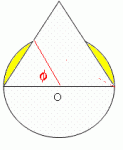Finding the area of a shaded region....
There is a circle centered at O, has a diameter at 10 cm and triangle ABC is equilateral. What is the area of the shaded regions?
So I am not sure how to post a picture of it but basically we have a circle that has a triangle on the right side of it and the circle is centered where the base of the triangle is. So the base of the triangle would be 10 cm along with the diameter of the circle. The triangle points beyond the right side of the circle and the shaded region would be the two small area the triangle doesn't cover on the right side of the circle.
I can find the area of the circle and the triangle and I know that the area of 1/2 the circle + the area of the triangle is missing the area of the shaded region. I just can't figure out how to solve this problem....Please help!
There is a circle centered at O, has a diameter at 10 cm and triangle ABC is equilateral. What is the area of the shaded regions?
So I am not sure how to post a picture of it but basically we have a circle that has a triangle on the right side of it and the circle is centered where the base of the triangle is. So the base of the triangle would be 10 cm along with the diameter of the circle. The triangle points beyond the right side of the circle and the shaded region would be the two small area the triangle doesn't cover on the right side of the circle.
I can find the area of the circle and the triangle and I know that the area of 1/2 the circle + the area of the triangle is missing the area of the shaded region. I just can't figure out how to solve this problem....Please help!


